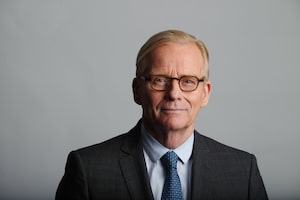Air Canada jets are seen at a Calgary airport in 2007 – the A319 above and notoriously noisy A320 below. The notoriously noisy A320 aircraft make up about 20 per cent of traffic at Toronto’s Pearson International Airport, which recently announced plans to offer incentives for airlines to use quieter planes. Calgary, Alta.---June 2007--- Airbus jets belonging to Air Canada at Calgary. Top is an A319 and bottom is an A320. digital photo by Larry MacDougalLarry MacDougal/The Globe and Mail
Transport Minister Marc Garneau has formally asked Air Canada to retrofit about 100 Airbus passenger planes to eliminate a loud whistling noise under the wings that has led to noise complaints from residents near Toronto, Montreal and Vancouver airports.
The notoriously noisy A320 family of aircraft make up about 20 per cent of traffic at Toronto's Pearson International Airport, which recently announced plans to offer incentives for airlines to use quieter planes.
In a Dec. 22 letter to Air Canada president and CEO Calin Rovinescu, the Transport Minister said Canadians living near Pearson and other major airports have for too long complained about the high-pitched whistling sound from the Airbus jets as they approach for landing.
Air Canada owns 42 Airbus A320s and 58 other narrow-body aircraft from the same family.
"As the Air Canada fleet makes up the vast majority of movements by the A320 family of aircraft in Canada, and in the spirit of noise reduction in the vicinity of airports, I am requesting that Air Canada and Air Canada Rouge commit to expeditiously develop a program for an accelerated retrofit," Mr. Garneau wrote in a letter obtained by The Globe and Mail.
Mr. Garneau said Airbus manufactures an affordable air-flow deflector known as a "vortex generator" that can be mounted upstream of the fuel-over-pressure protector cavities under the wings that cause the whistling noise. A federal official said the retrofits would cost $7,000 to $25,000 per aircraft, depending on the age of the A320.
"This retrofit will be positively received by airports and communities across Canada, including those near Aeroports de Montreal and Toronto Lester B. Pearson International Airport," Mr. Garneau wrote. "This retrofit would lead to a tangible impact on noise, with potential reductions of 5 to 11 decibels for A320 Aircraft."
At the moment, Mr. Garneau is not ordering Air Canada to do the retrofits, but expects the airline to do so voluntarily.
"I believe that a voluntary approach by Air Canada and Air Canada Rouge is the best option," Mr. Garneau said in his letter. "It is reflective of Air Canada's stated commitment to integrating environmental considerations into its business decisions and to minimize its environmental footprint partly through less noise in our communities."
Air Canada spokesperson Peter Fitzpatrick acknowledged on Thursday that the company received the letter and is reviewing the request.
"Our Maintenance and Engineering specialists will review the recommendations made, taking into account cost, aircraft down-time, current maintenance schedule and narrow-body fleet renewal commitments," Mr. Fitzpatrick said in an e-mail.
If the airline does not make the noise changes, Mr. Garneau could issue a direct order or the government could press all the airports to use financial incentives such as landing and take-off fees to encourage Air Canada to operate quieter aircraft.
Air Canada has undertaken a $9-billion renewal of its fleet, including the purchase of 37 Boeing 787 Dreamliners and 61 of the new 737 Max 9. Both are regarded as quiet and fuel-efficient.
Peter Bayrachny of the lobby group Neighbours Against the Airport Noise said the noise mufflers will make a difference to people in the Markland Wood area of Etobicoke, which is near Pearson's north and south runways.
"When the planes come in over Markland, they are at maybe 900 to 1,000 feet, so it will certainly help with the noise," Mr. Bayrachny said in an interview on Thursday.
Mr. Bayrachny said the longer-term problem is the increased traffic volume at Pearson, which is forecast to reach 85 million passengers by 2035. His group wants Ottawa to instruct the airlines to use Hamilton Airport for charter aircraft to reduce the number of flights into Pearson, Canada's busiest airport.
"Every major city in North America, and Toronto is the fourth largest metropolis in North America, has at least two airports, and Pearson can't grow any more. You cannot fit all of that traffic into Pearson," he said. "That tells me you need another airport, and Hamilton is already there."
The Greater Toronto Airports Authority (GTAA), which is beginning work on its own quieter-fleet incentive program to apply to all the airports it manages, has also raised the possibility of providing noise insulation to homes in the busiest flight paths.
A recent study for the GTAA and NAV Canada, operator of the country's civil air navigation service, found that more than half of comparable airports employ more stringent anti-noise rules at night than during the day, and those rules are in effect for longer.
The study found that Pearson's night period starts later and generally ends earlier than those of other airports.
 Robert Fife
Robert Fife